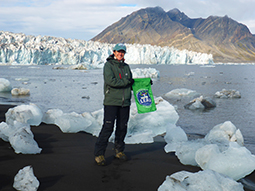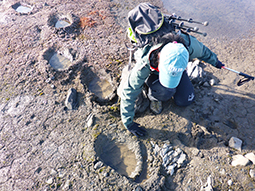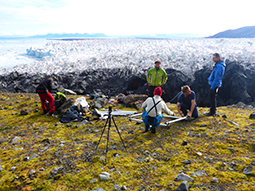
Photo courtesy of: Nina AdaninDoctoral student, Nina Adanin, plants The Patton College flag at the North Pole.
Nina Adanin is no stranger to adventure. A former high-altitude mountain guide, she has scaled Mount Everest and Mount McKinley and even sailed across the Atlantic from Gibraltar to the Caribbean.
“I like Indiana Jones movies,” she said, laughing. “Adventures and expeditions are my passion.”
Adanin, a first-year doctoral student in Instructional Technology with a focus in distance-learning in extreme environments, had another adventure in August: she – and a team of researchers – spent two weeks in the Arctic researching glaciology for a project, “Glaciers on the Move.”
Adanin studied surging glaciers with a research team from University of Scotland and Norway University. The team included Drs. Charles Amory, Heidi Sevestre, Anatoly Sinitsyn, and David Wrangborg. They were stationed in Svalbard, an archipelago between Norway and the North Pole.
“We’re trying to observe how glaciers move, their speed, and their impact,” said Adanin, who is from Serbia. “The project will increase knowledge of surging glaciers and raise awareness on the uniqueness of these glaciers and their effect on the polar environment.”
The project will result in the world’s first comprehensive crowd-sourced glacier atlas hosted on an open-source digital platform, MELT, which will allow people to better understand glaciers. It will also lead to an exhibit that will be displayed in Svalbard Museum and, ultimately, throughout Europe.
“Many people do not have an opportunity to visit or research in extreme environments, but they can still learn about what it is like,” said Adanin, who received her master’s in Outdoor Recreation and Education from The Patton College in 2018. “I hope my research helps people understand how climate change is happening – and why.”
The team recorded glaciers moving roughly five meters (16.4 feet) per day. They set up 360- and time-lapse cameras to collect data, monitor movement, and facilitate distance-learning.
“Ice is an important part of climate,” said Adanin. “Glaciers can slide and affect marine life, cities, and coastal towns all along Northern Europe.”
Wildlife depend on ice for access to other lands. Reindeer, for example, need ice to move from one area to the next and hunt for food.
“Without ice, they cannot move,” said Adanin. “They have less land to explore.”
Reindeer, however, were not the team’s most pressing concern; polar bears were. There are roughly 3,000 polar bears in Svalbard – and Adanin saw several.
“We only slept four hours per day because we always had bear watches,” she said. “We worked all day collecting data, but we had to be careful. Polar bears are huge and dangerous, and when they see people, all they see is a piece of meat and they can attack.”
When needed, the research team fired flare guns toward the sky to ward off approaching bears. Fortunately, no encounters occurred.
For Adanin, though, risk is par for the course. Her adventures have taken her to South America, Africa, Russia, and beyond. In fact, she was part of the 2013 expedition in Pakistan that resulted in the death of 11 climbers, who were killed by members of the Taliban. Adanin hid behind a rock and survived.
“That was my last climbing expedition,” she said. “If you don’t have a clear mind, it’s not good to climb because you could easily die.”
Adanin, who teaches classes in Expedition Planning and Management, Rock Climbing, and Winter Wilderness Living Skills, brings a unique perspective to the classroom. She expressed gratitude to The Patton College for supporting her research.
“The Patton College and the Curriculum & Technology Center were extremely helpful throughout this process and special GRID Lab,” she said. “They provided access to the GRID Lab, equipment, 360 cameras, microphones, and cases to assist with research. I hope that others will benefit from our work.”

Photo courtesy of: Nina AdaninResearchers had to take turns watching for polar bears. There are approximately 3,000 in the area...with really big feet!

Photo courtesy of: Nina AdaninAdanin studied surging glaciers with a research team from University of Scot-land and Norway University.